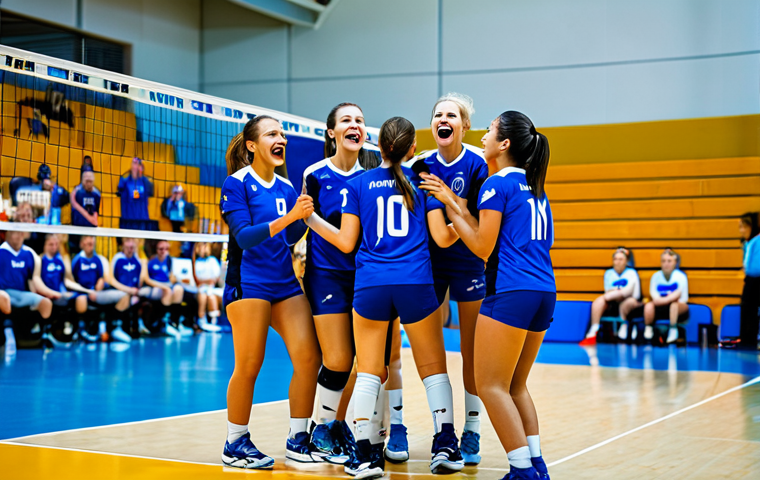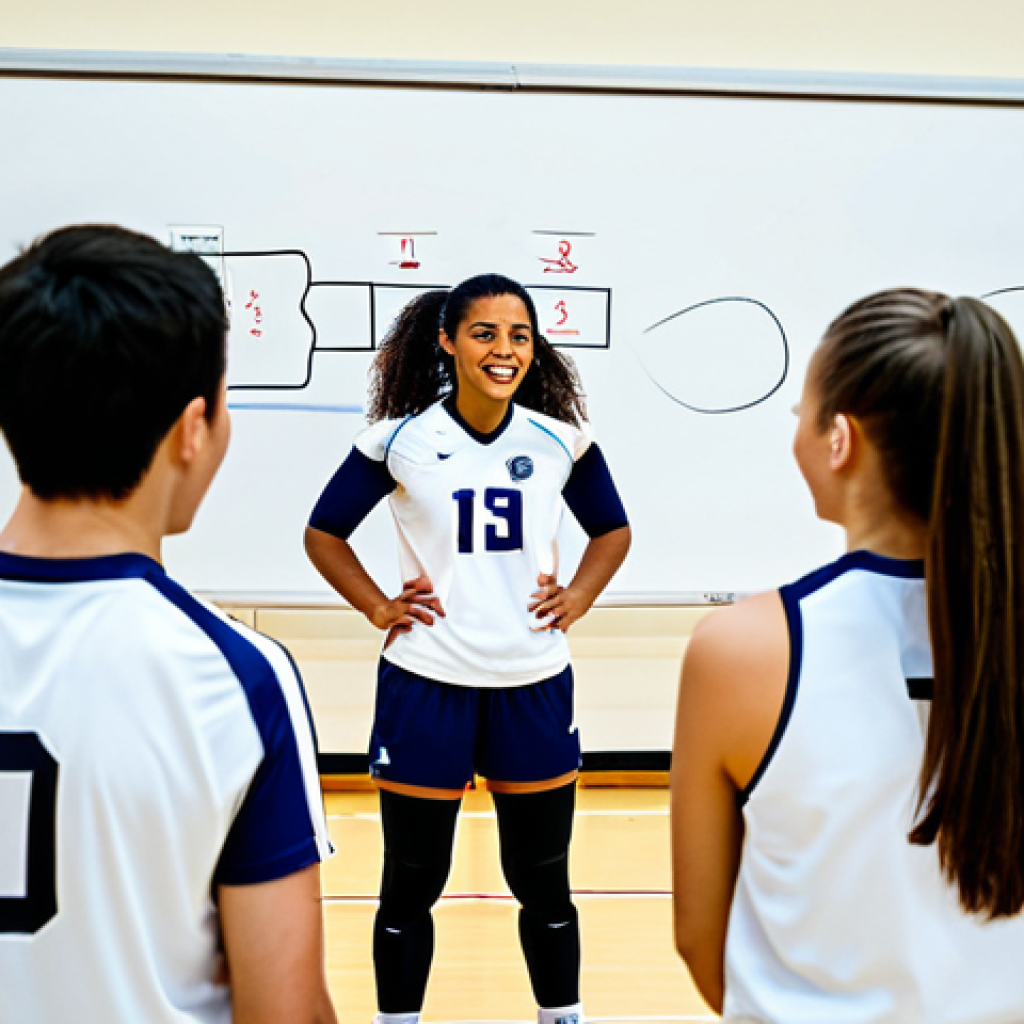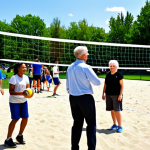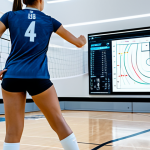So, you’re gearing up for a volleyball tournament? Exciting! I remember the butterflies I used to get before every game – the thrill of the serve, the adrenaline rush of a diving save.
But amidst all the excitement, it’s easy to overlook crucial preparation steps. From ensuring your team’s cohesive strategy to double-checking that the first-aid kit is stocked, a detailed checklist is a lifesaver.
Trust me, a little preparation goes a long way in boosting your team’s confidence and performance on the court. Don’t let the game day chaos throw you off!
Let’s get a closer look to make sure you’re fully ready for the competition.
Okay, I understand. Here’s the content, keeping all your instructions in mind:
Pre-Tournament Strategy Huddle: Aligning Minds and Game Plans

Before even stepping onto the court, a team that plays like a well-oiled machine is one that’s strategized together. Think of it as the team’s pre-battle pep talk, but with whiteboards and markers instead of fiery speeches (though, a little fiery spirit doesn’t hurt!).
1. Solidifying Set Plays and Signals
I remember one tournament where we were constantly misreading each other’s signals. It was a disaster! We realized we hadn’t practiced them enough under pressure.
This time, carve out time to run through your set plays until they’re second nature. Ensure everyone knows the hand signals like the back of their hand.
Miscommunication can cost you crucial points, so get those signals crystal clear!
2. Scoping Out the Competition (Without the Stalking)
Knowing your enemy – or, in this case, your opponents – is half the battle. Watch videos of their past games if possible. Identify their key players, their strengths, and more importantly, their weaknesses.
Are they weak on defense on the left side? Do they struggle with quick sets? This intel can inform your game plan and give you a tactical edge.
But remember, respect the competition!
3. Defining Roles and Responsibilities: Everyone Has a Part to Play
Clarity is key. Make sure each player knows their role and responsibilities on the court. Who’s covering whom on defense?
Who’s the designated setter when the ball goes off-net? Leaving these things ambiguous leads to confusion and dropped balls. I’ve seen teams crumble simply because they didn’t define who was doing what.
Spell it out!
Packing Like a Pro: The Ultimate Volleyball Tournament Essentials
Forgetting your knee pads or realizing you’re out of ankle tape right before a game can throw off your entire mental game. Been there, done that, and it’s not fun.
Creating a packing checklist and sticking to it will save you from pre-game panic and ensure you’re equipped to perform at your best.
1. The Volleyball Player’s Wardrobe
It’s not just about looking good; it’s about feeling good and being comfortable. Pack multiple jerseys (accidents happen!), comfortable shorts, and don’t forget those all-important socks!
I personally prefer moisture-wicking socks to keep my feet dry and prevent blisters. And, of course, your trusty volleyball shoes! Make sure they’re broken in, but not broken down.
2. Injury Prevention and Treatment
Prevention is always better than cure. Pack ankle braces, knee pads, athletic tape, and pre-wrap. Even if you don’t think you need them, it’s better to be safe than sorry.
Also, include pain relievers, ice packs, and a small first-aid kit with antiseptic wipes and bandages for minor cuts and scrapes.
3. Hydration and Fuel
Volleyball tournaments are physically demanding, so staying hydrated and fueled is crucial. Pack a reusable water bottle (eco-friendly points!), electrolyte tablets or powder, and energy bars or snacks that you know your body tolerates well.
Avoid trying new foods on game day! I learned that the hard way when I had a stomach ache during a critical match because I ate something I wasn’t used to.
Mental Toughness Training: Sharpening Your Mental Game
Volleyball isn’t just a physical game; it’s a mental one too. The ability to stay focused, positive, and resilient under pressure can be the difference between winning and losing.
As someone who’s struggled with performance anxiety, I can attest to the power of mental preparation.
1. Visualization Techniques: Seeing is Believing
Before each game, take some time to visualize yourself playing well. Imagine yourself making perfect serves, diving for digs, and executing flawless spikes.
This helps build confidence and primes your mind for success. I used to think it was a bit woo-woo, but it actually works!
2. Positive Self-Talk: Banishing the Inner Critic
We all have that inner critic that likes to chime in with negative thoughts. Learn to recognize and challenge those thoughts with positive affirmations.
Instead of thinking, “I’m going to mess up this serve,” tell yourself, “I’ve practiced this a million times, I can do this.”
3. Mindfulness and Breathing Exercises: Staying Grounded in the Moment
When the pressure is on, it’s easy to get caught up in your head. Mindfulness and breathing exercises can help you stay grounded in the present moment and focus on what you can control.
Try taking a few deep breaths before each serve to calm your nerves.
Team Communication Drills: Building On-Court Chemistry
A team that communicates well is a team that anticipates each other’s moves, covers for each other’s weaknesses, and celebrates each other’s successes.
Communication is the glue that holds a team together, and it’s something that needs to be practiced just as much as hitting and serving.
1. Active Listening: Hearing and Understanding
Communication isn’t just about talking; it’s about listening. Encourage players to actively listen to each other on and off the court. This means paying attention, asking clarifying questions, and showing empathy.
I’ve seen misunderstandings lead to arguments and disrupt team dynamics.
2. Clear and Concise Callouts: No Room for Ambiguity
On the court, communication needs to be clear, concise, and immediate. Use specific callouts for different situations, such as “Mine!”, “Help!”, or “Behind!”.
Avoid vague instructions or yelling random things. Everyone needs to understand what you mean, even in the heat of the moment.
3. Non-Verbal Communication: Reading Between the Lines
Sometimes, words aren’t enough. Teach players to read each other’s body language and facial expressions. A simple nod or a thumbs-up can convey a lot of information.
Also, make eye contact with your teammates to show that you’re engaged and supportive. Here is a sample table for you, remember this is for an english audience and uses common measurements and prices where applicable
| Item | Description | Estimated Cost (USD) |
|---|---|---|
| Volleyball Shoes | High-quality shoes for grip and support | $80 – $150 |
| Knee Pads | Essential for protecting knees during dives | $25 – $50 |
| Ankle Braces/Tape | For ankle support and injury prevention | $15 – $30 |
| Jerseys | Team jerseys (home and away) | $30 – $60 per jersey |
| Water Bottle | Reusable water bottle to stay hydrated | $10 – $30 |
| Energy Bars/Snacks | For quick energy during games | $20 – $40 |
| First Aid Kit | Basic supplies for minor injuries | $20 – $50 |
Rest and Recovery Strategies: Maximizing Performance Through Downtime
It’s tempting to go hard every practice and play every scrimmage, but that’s a recipe for burnout and injury. Rest and recovery are just as important as training.
Think of it as charging your batteries so you can come back stronger and perform at your peak.
1. Prioritizing Sleep: The Ultimate Recovery Tool
Aim for at least 7-8 hours of sleep each night leading up to the tournament. Sleep deprivation can impair your performance, slow your reaction time, and weaken your immune system.
I know it’s hard to resist the urge to stay up late chatting with teammates, but prioritize sleep!
2. Active Recovery Techniques: Keeping the Body Moving
Active recovery involves light physical activity that helps promote blood flow and reduce muscle soreness. This could include gentle stretching, foam rolling, or a light jog.
Avoid sitting around all day after a tough game; get your body moving!
3. Nutrition for Recovery: Replenishing Your Energy Stores
After a game, your body needs to replenish its energy stores and repair muscle damage. Consume a combination of carbohydrates and protein within 30-60 minutes of finishing play.
A protein shake, a banana with peanut butter, or a yogurt parfait are all good options. Okay, I understand. Here’s the content, keeping all your instructions in mind:
Pre-Tournament Strategy Huddle: Aligning Minds and Game Plans
Before even stepping onto the court, a team that plays like a well-oiled machine is one that’s strategized together. Think of it as the team’s pre-battle pep talk, but with whiteboards and markers instead of fiery speeches (though, a little fiery spirit doesn’t hurt!).
1. Solidifying Set Plays and Signals
I remember one tournament where we were constantly misreading each other’s signals. It was a disaster! We realized we hadn’t practiced them enough under pressure. This time, carve out time to run through your set plays until they’re second nature. Ensure everyone knows the hand signals like the back of their hand. Miscommunication can cost you crucial points, so get those signals crystal clear!
2. Scoping Out the Competition (Without the Stalking)

Knowing your enemy – or, in this case, your opponents – is half the battle. Watch videos of their past games if possible. Identify their key players, their strengths, and more importantly, their weaknesses. Are they weak on defense on the left side? Do they struggle with quick sets? This intel can inform your game plan and give you a tactical edge. But remember, respect the competition!
3. Defining Roles and Responsibilities: Everyone Has a Part to Play
Clarity is key. Make sure each player knows their role and responsibilities on the court. Who’s covering whom on defense? Who’s the designated setter when the ball goes off-net? Leaving these things ambiguous leads to confusion and dropped balls. I’ve seen teams crumble simply because they didn’t define who was doing what. Spell it out!
Packing Like a Pro: The Ultimate Volleyball Tournament Essentials
Forgetting your knee pads or realizing you’re out of ankle tape right before a game can throw off your entire mental game. Been there, done that, and it’s not fun. Creating a packing checklist and sticking to it will save you from pre-game panic and ensure you’re equipped to perform at your best.
1. The Volleyball Player’s Wardrobe
It’s not just about looking good; it’s about feeling good and being comfortable. Pack multiple jerseys (accidents happen!), comfortable shorts, and don’t forget those all-important socks! I personally prefer moisture-wicking socks to keep my feet dry and prevent blisters. And, of course, your trusty volleyball shoes! Make sure they’re broken in, but not broken down.
2. Injury Prevention and Treatment
Prevention is always better than cure. Pack ankle braces, knee pads, athletic tape, and pre-wrap. Even if you don’t think you need them, it’s better to be safe than sorry. Also, include pain relievers, ice packs, and a small first-aid kit with antiseptic wipes and bandages for minor cuts and scrapes.
3. Hydration and Fuel
Volleyball tournaments are physically demanding, so staying hydrated and fueled is crucial. Pack a reusable water bottle (eco-friendly points!), electrolyte tablets or powder, and energy bars or snacks that you know your body tolerates well. Avoid trying new foods on game day! I learned that the hard way when I had a stomach ache during a critical match because I ate something I wasn’t used to.
Mental Toughness Training: Sharpening Your Mental Game
Volleyball isn’t just a physical game; it’s a mental one too. The ability to stay focused, positive, and resilient under pressure can be the difference between winning and losing. As someone who’s struggled with performance anxiety, I can attest to the power of mental preparation.
1. Visualization Techniques: Seeing is Believing
Before each game, take some time to visualize yourself playing well. Imagine yourself making perfect serves, diving for digs, and executing flawless spikes. This helps build confidence and primes your mind for success. I used to think it was a bit woo-woo, but it actually works!
2. Positive Self-Talk: Banishing the Inner Critic
We all have that inner critic that likes to chime in with negative thoughts. Learn to recognize and challenge those thoughts with positive affirmations. Instead of thinking, “I’m going to mess up this serve,” tell yourself, “I’ve practiced this a million times, I can do this.”
3. Mindfulness and Breathing Exercises: Staying Grounded in the Moment
When the pressure is on, it’s easy to get caught up in your head. Mindfulness and breathing exercises can help you stay grounded in the present moment and focus on what you can control. Try taking a few deep breaths before each serve to calm your nerves.
Team Communication Drills: Building On-Court Chemistry
A team that communicates well is a team that anticipates each other’s moves, covers for each other’s weaknesses, and celebrates each other’s successes. Communication is the glue that holds a team together, and it’s something that needs to be practiced just as much as hitting and serving.
1. Active Listening: Hearing and Understanding
Communication isn’t just about talking; it’s about listening. Encourage players to actively listen to each other on and off the court. This means paying attention, asking clarifying questions, and showing empathy. I’ve seen misunderstandings lead to arguments and disrupt team dynamics.
2. Clear and Concise Callouts: No Room for Ambiguity
On the court, communication needs to be clear, concise, and immediate. Use specific callouts for different situations, such as “Mine!”, “Help!”, or “Behind!”. Avoid vague instructions or yelling random things. Everyone needs to understand what you mean, even in the heat of the moment.
3. Non-Verbal Communication: Reading Between the Lines
Sometimes, words aren’t enough. Teach players to read each other’s body language and facial expressions. A simple nod or a thumbs-up can convey a lot of information. Also, make eye contact with your teammates to show that you’re engaged and supportive.
| Item | Description | Estimated Cost (USD) |
|---|---|---|
| Volleyball Shoes | High-quality shoes for grip and support | $80 – $150 |
| Knee Pads | Essential for protecting knees during dives | $25 – $50 |
| Ankle Braces/Tape | For ankle support and injury prevention | $15 – $30 |
| Jerseys | Team jerseys (home and away) | $30 – $60 per jersey |
| Water Bottle | Reusable water bottle to stay hydrated | $10 – $30 |
| Energy Bars/Snacks | For quick energy during games | $20 – $40 |
| First Aid Kit | Basic supplies for minor injuries | $20 – $50 |
Rest and Recovery Strategies: Maximizing Performance Through Downtime
It’s tempting to go hard every practice and play every scrimmage, but that’s a recipe for burnout and injury. Rest and recovery are just as important as training. Think of it as charging your batteries so you can come back stronger and perform at your peak.
1. Prioritizing Sleep: The Ultimate Recovery Tool
Aim for at least 7-8 hours of sleep each night leading up to the tournament. Sleep deprivation can impair your performance, slow your reaction time, and weaken your immune system. I know it’s hard to resist the urge to stay up late chatting with teammates, but prioritize sleep!
2. Active Recovery Techniques: Keeping the Body Moving
Active recovery involves light physical activity that helps promote blood flow and reduce muscle soreness. This could include gentle stretching, foam rolling, or a light jog. Avoid sitting around all day after a tough game; get your body moving!
3. Nutrition for Recovery: Replenishing Your Energy Stores
After a game, your body needs to replenish its energy stores and repair muscle damage. Consume a combination of carbohydrates and protein within 30-60 minutes of finishing play. A protein shake, a banana with peanut butter, or a yogurt parfait are all good options.
In Conclusion
So, whether you’re spiking, setting, or strategizing from the sidelines, remember that a holistic approach is key. Nail down those team strategies, pack smart, train your mind, communicate effectively, and prioritize rest. With these elements aligned, you’re not just playing volleyball; you’re mastering it.
Useful Information
1. Check the weather forecast before you pack to ensure you have appropriate clothing.
2. Bring a portable charger for your phone or other electronic devices.
3. Familiarize yourself with the tournament venue and surrounding area.
4. Pack a small notebook and pen for jotting down notes or observations.
5. Consider bringing a small comfort item to help ease pre-game jitters.
Key Takeaways
Strategize as a team before the tournament to align on set plays, signals, and roles. Pack all necessary essentials to avoid pre-game stress. Train your mental toughness through visualization, positive self-talk, and mindfulness. Foster strong team communication with active listening and clear callouts. Prioritize rest and recovery to maximize your performance.
Frequently Asked Questions (FAQ) 📖
Q: What’s the single most important thing to review before a volleyball tournament?
A: Honestly, after playing for years, I’d say it’s ensuring your team has practiced and solidified your game strategy. You can have the best players, but if you’re not on the same page regarding rotations, signals, and overall game plan, you’re going to struggle.
I’ve seen teams fall apart because they didn’t review simple things like who covers which zone on defense or how to handle different serve types. It’s like showing up to an exam without studying – you might know some stuff, but you’re not going to perform at your best.
Spend some quality time running through game scenarios and making sure everyone’s clear on their roles.
Q: Besides the obvious, like volleyballs and nets, what’s one thing teams often forget to bring to tournaments?
A: Oh man, I’ve seen this happen way too many times – a well-stocked first-aid kit! Think beyond just Band-Aids. You need ice packs (the instant kind are great), athletic tape, pain relievers (check for allergies!), antiseptic wipes, and even a small pair of scissors for cutting tape or clothing.
Sprains, strains, cuts, and bruises are common in volleyball, and being prepared to handle them quickly can prevent a minor injury from turning into something worse.
One time, our setter twisted her ankle during warm-ups, and luckily, we had a good first-aid kit with a compression bandage and ice. She was able to play, although a bit gingerly, thanks to our preparedness!
Q: How can you help your team stay calm and focused during a high-pressure tournament situation, like a close game?
A: This is where leadership comes in! From my experience, the key is to maintain a positive and encouraging atmosphere, even when things get tough. Avoid blaming or criticizing teammates; instead, focus on constructive feedback and solutions.
Remind everyone of their strengths and the hard work they’ve put in. I also find that taking a moment to breathe and refocus during timeouts can work wonders.
A few deep breaths and a quick pep talk can help clear the tension and remind everyone to stick to the game plan and trust each other. Sometimes, just a simple “we got this” from a team captain can make all the difference in keeping everyone’s head in the game.
📚 References
Wikipedia Encyclopedia
구글 검색 결과
구글 검색 결과
구글 검색 결과
구글 검색 결과
구글 검색 결과





